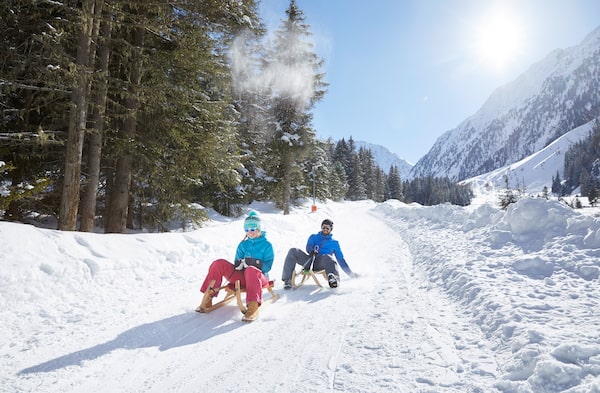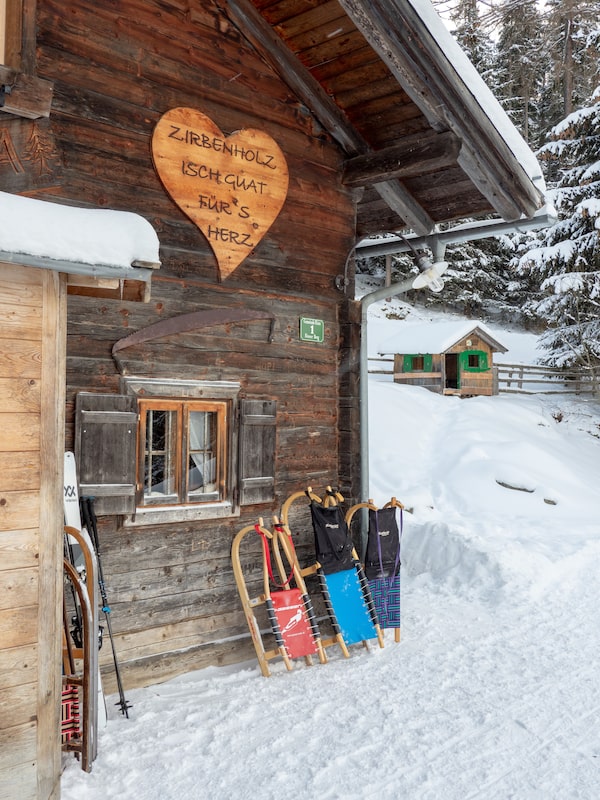Keep up to date with the weekly Sightseer newsletter. Sign up today.

Sledders slide down a rodelling run in Innsbruck, Austria.Handout
It occurred to me, as I perched in a stranger’s lap on a sled seat the size of a placemat and flew down an Austrian Alp in the dark, that maybe I’d strayed too far outside my comfort zone. And maybe, for once, this wasn’t a good thing.
My arms clutched a backpack to my chest and my legs stuck out over the snow as my thighs clenched the wooden rungs of the sled. His legs wrapped around mine; his left arm bent around my waist to reach the sled rope while his right steered and kept me centred. One wrong swerve and we’d fly off this icy rodelling run that wound down Rangger mountain and hit the trees.
On his command, I’d drop my boot into the snow to slow down on switchbacks then raise it again to gain speed on straightaways. My legs ached, wind and snow-spray stung my cheeks, but I was so in the moment it felt like time had stopped.
We zipped down so quickly (on what I later discovered was a €300 racing sled) that we left the rest of our party far behind. When we stopped to wait, the beam from his headlamp did little to push back the pitch black, though the lights of Innsbruck twinkled in the distance. The silence between us was awkward and absolute. I finally let the absurdity of my situation sink in; I didn’t know this man’s name, but he and his two friends had just saved me and my injured friend from spending a cold night on the mountain.
“What would you two have done if we hadn’t been here?” he finally asked.
Good question.
People who love travel generally like to step out of our comfort zone – that’s why we go exploring. But how can we make sure we don’t push ourselves too far? Looking back on my Austrian adventure, I thought I’d try to figure this out, because I know I’ll be back in the mountains as soon as we’re able to travel again.
Karla Boluk, an associate professor at University of Waterloo’s Department of Recreation and Leisure Studies, cautions that “the onus is on us” to assess risk, whether it’s pandemic precautions or wearing a helmet.
“We each have a responsibility to do our homework and plan accordingly before we leave home,” Boluk says. “Even pre-COVID, countries were considering how to advise visitors to travel more safely.” One example is the Tiaki Promise developed by New Zealand, five principles tied to the Maori culture’s connection between the land and its people. The covenant asks visitors to protect nature, keep the country clean, drive carefully, show respect and be prepared. On the tourism website, “be prepared” includes a link to a list of precautions to take before heading into the mountains.
I must admit that I did not think to research rodelling and how racing down a narrow, winding mountain path was as different from the tobogganing of my childhood as a beaver is from an eagle. It just looked fun.
The Rangger Kopfl resort offers night sledding along a 10-kilometre run.casey moore/Handout
My friend Karin and I had arrived in Innsbruck, a town surrounded by the Alps, after a long train ride from Vienna. Night sledding at nearby Rangger Kopfl resort – a 10-kilometre run! – with a traditional Austrian meal at a mountain hut sounded like a great idea, even when we learned that after two gondolas we’d need to hike another two kilometres uphill on an unlit path. No problem, the moon was full. But dinner at Rosskogelhutte would have to be quick to give us enough time to sled down and catch the last cable car and then the last bus back to Innsbruck. Totally worth it, we thought, since it would be a great introduction to Tyrolean culture.
And it was – including the valuable lesson that you can’t assume someone has your back safety-wise when you’re in the Alps.
“It’s the perfect example of the cultural schism when it comes to individual responsibility and risk,” Leslie Anthony, the Whistler-based editor of Mountain Life Annual, says when I tell him my story. “There are more people familiar with alpine culture in Austria that would know what they were getting into.”
In other words: Just because something seems safe to locals who have grown up on the mountains doesn’t mean it’s going to be safe for clueless foreigners.
James Cooper, the ski guide I met later in my stay, experienced this when he moved there from the United Kingdom with his young family eight years ago. “There is a cultural element to [risk] that surprised us,” he tells me.
“Kids [aged] 6 or 7 are out walking in the mountains three or four times a year. They’ll go places that would give [most] primary schools a heart attack on the risk-assessment.”
It makes sense. Mountain culture, as my friend and I learned, is about more than just enjoying life at higher altitudes – it’s also about knowing how to stay safe at higher altitudes.

Sleds rest outside a mountain hut in Tirol, Austria.Markus Jenewein/Handout
Our sledding night started simply enough. We took in scenic views of the valley lights as we ascended in two chilly gondolas. After warming up with a mug of mulled wine, we collected our sleds. But the final trek to reach the hut for dinner (at 1,777-metre elevation) took longer than expected; dragging those heavy sleds was hard work. Fortunately, our meal of sausage, spinach dumplings and sauerkraut arrived quickly, and within 25 minutes we were slowly sledding back down the steep path in the dark.
Karin made her way tentatively while I started to have fun and whooped past her, hoping my enthusiasm might ease her fears. But why hadn’t someone told us to rent headlamps or a helmet? Why hadn’t I thought to ask?
Other sledders flew by, but even the floodlit section was slow-going for us. Then Karin crashed on an icy pitch. And by the time we reached the gondola, I could see she was in a lot of pain. Oh, and the gondola had just closed for the night.
Would this snafu have occurred in the more risk-averse resorts of North America? I’m not sure. “That was one of the things l love about Europe," Anthony says with a laugh. "You can do things there they’d never let you do in Canada or the U.S.”
He adds that visitors often ignore the degree of risk they’ve accepted by being in the mountains and also don’t understand how much risk is managed for them by the operators of recreational facilities. “People don’t think about that at all: So how much is on me? And how much is being managed for me? And what’s reasonable for me to expect? It’s a push and pull.”
On this two-way street of risk and responsibility, Karin and I clearly took a wrong turn. We expected to be kept safe instead of taking on more of that responsibility ourselves.
But I wasn’t thinking such reasoned thoughts that night. We hadn’t panicked – yet – but clearly getting off the mountain would be tricky. Then, with a rooster tail of snow-spray, a trio of sledders pulled to a stop in front of us.
“You’ve got about an hour’s walk down the mountain,” one said, “or you can come with us.” The woman smiled kindly, while the two men moved back on their seats and opened their legs a little wider to make room.
It was one of those travel moments where you operate on blind faith. The risk of snuggling in with strangers outweighed the danger of spending a night in the snow. We hopped on for the ride of our lives.
The writer was a guest of Innsbruck Tourism. It did not review or approve the story.
 Catherine Dawson March
Catherine Dawson March